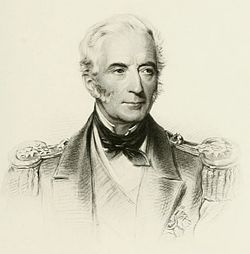- Michael Seymour (Royal Navy officer)
-
Sir Michael Seymour 
Vice Admiral Michael Seymour. Engraving by F Holl after an original by A. de SalomeBorn 3 December 1802 Died 23 February 1887
Horndean, HampshireAllegiance  United Kingdom
United KingdomService/branch  Royal Navy
Royal NavyYears of service 1813–1870 Rank Admiral Commands held China Station
Portsmouth CommandBattles/wars Crimean War,
Second Opium WarAwards Knight Grand Cross of the Order of the Bath Admiral Sir Michael Seymour, GCB (3 December 1802 – 23 February 1887), was a Royal Navy officer who went on to be Commander-in-Chief, Portsmouth.
Contents
Born the third son of Admiral Sir Michael Seymour, 1st Baronet,[1] Michael Seymour entered the Royal Navy in 1813.[1] He was made Lieutenant in 1822, Commander in 1824 and was posted Captain in 1826.[1] From 1833 to 1835 he was captain of the survey ship Chile.[1] In 1841 he was given command of HMS Britannia and then of HMS Powerful.[1] In 1845 he took over HMS Vindictive.[1]
From 1851 to 1854 he was Commodore Superintendent of Devonport Dockyard.[1] In 1854 he served under Sir Charles Napier in the Baltic during the Crimean War.[1] He was promoted to Rear-Admiral that same year and, when the Baltic campaign was resumed in 1855 under Admiral the Hon. Richard Dundas, Seymour was second in command.[1]
On 19 February 1856 he was appointed commander-in-chief of the East Indies and China Station.[1] Flying his flag in HMS Calcutta,[1] he conducted operations arising from the attack on the British Coaster Arrow,[1] helped destroy the Chinese fleet in June 1857,[1] took Canton in December,[1] and in 1858 he captured the forts on the Baihe (Hai River),[1] compelling the Chinese government to consent to the Treaties of Tianjin.[1] He was made GCB in 1859.[1] He sat as a Liberal Member of Parliament for Devonport from 1859 to 1863.[1] In 1863 he was made Commander-in-Chief, Portsmouth, a post he held until 1866.[1] He retired in 1870.[1]
Family
In 1829 he married Dorothy Knighton: they had a son and three daughters.[1] He was the uncle of Sir Edward Hobart Seymour, also an admiral.
References
External links
- Hansard 1803–2005: contributions in Parliament by Michael Seymour
Military offices Preceded by
Sir James StirlingCommander-in-Chief, East Indies and China Station
1856–1859Succeeded by
Sir James HopeParliament of the United Kingdom Preceded by
Thomas Erskine Perry and
James WilsonMember of Parliament for Devonport
1859–1863
With: James Wilson, to August 1859
Sir Arthur William Buller, from August 1859Succeeded by
William Ferrand and
Sir Arthur William BullerMilitary offices Preceded by
Sir Henry BruceCommander-in-Chief, Portsmouth
1863–1866Succeeded by
Sir Thomas PasleyHonorary titles Preceded by
Sir Provo WallisVice-Admiral of the United Kingdom
1876–1887Succeeded by
Office abolished
(recreated in 1901 with
Sir Michael Culme-Seymour, Bt)Categories:- 1802 births
- 1887 deaths
- People connected with Plymouth
- Royal Navy personnel of the Crimean War
- British military personnel of the Second Opium War
- Royal Navy admirals
- Knights Grand Cross of the Order of the Bath
- Liberal Party (UK) MPs
- Members of the United Kingdom Parliament for English constituencies
- UK MPs 1859–1865
- Younger sons of baronets
- Seymour family
Wikimedia Foundation. 2010.
